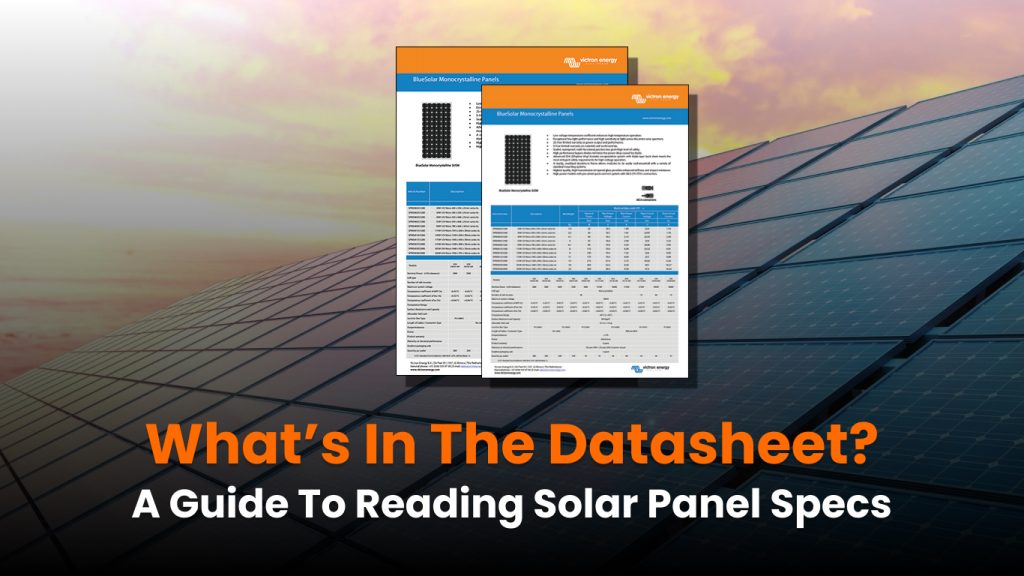So, you’ve found a solar panel that looks promising. You open the datasheet to learn more—and suddenly, you feel like you need an engineering degree just to make sense of it. Don’t worry! Understanding solar panel datasheets isn’t as complicated as it seems. In this guide, we’ll break down a typical datasheet so you can confidently choose the best panel for your needs.
The first page: Key highlights
The first page of a datasheet is usually designed for the average customer. It typically includes:
- Panel name and model
- Power output (in watts)
- A photo of the panel
- A brief description of its features
Some datasheets may also include warranty details, certifications, and ideal applications. Occasionally, brands add an “About Us” section and contact details, while others dive straight into the technical specifications.
The second page: The technical breakdown
This is where things get serious—full of numbers and engineering terms. Let’s break them down.
Mechanical specifications
This section covers the panel’s physical characteristics:
- Size, weight, and thickness
- Materials used for the front cover, backsheet, and frame
- Solar cell type and quantity
Understanding solar cells
Solar cells are the heart of a solar panel. There are different types, each with unique characteristics:
- Monocrystalline vs. Polycrystalline: Monocrystalline cells (made from a single silicon crystal) are more efficient and produce more power, but they are more expensive. Polycrystalline cells (made from multiple silicon crystals) are cheaper but slightly less efficient.
- PERC (Passivated Emitter and Rear Cell): A special coating reduces energy loss and boosts efficiency, especially in low-light conditions.
- HJT (Heterojunction Technology): Combines amorphous and crystalline silicon layers to improve performance at high temperatures.
- Bifacial Cells: Capture sunlight from both sides of the panel, increasing energy production by up to 30%.
- Shingled Design: Slices solar cells into smaller pieces and overlaps them, improving durability and efficiency while enhancing aesthetics.
- Half-Cut Cells: Standard cells are split in half using a laser, reducing power loss and increasing shading resistance.
- N-Type vs. P-Type Cells: N-type cells (doped with phosphorus) degrade less over time compared to P-type cells (doped with boron).
The number of cells in a panel also hints at its application. Panels with 60/120 or 66/132 cells are common for residential use, while larger 72/144-cell panels are often used for commercial projects. However, high-output panels are increasingly popular for home systems.
Junction box, cables, and connectors
The junction box is the connection hub of the panel, protecting wiring from the elements. It usually has an IP67 rating, meaning it is resistant to dust and water jets.
Bypass diodes inside the junction box enhance shading tolerance by dividing the panel into independent sections. Most panels have 2-4 diodes. Connectors (often MC4) are listed at the end of this section and have their own IP ratings.
Electrical specifications
This section contains the most critical numbers for evaluating a solar panel’s performance.
Power output
Power output (measured in watts, W) indicates how much electricity a panel produces under Standard Test Conditions (STC).
Formula: PMPP=IMPP×VMPPP_{MPP} = I_{MPP} \times V_{MPP}
- PMPP: Power at Maximum Power Point
- IMPP: Current at Maximum Power Point
- VMPP: Voltage at Maximum Power Point
Solar panels have an IV curve (current-voltage curve) that represents performance under different sunlight and temperature conditions.
Power tolerance
Power tolerance refers to the expected range of power output under real-world conditions. A panel with +/-3% power tolerance on a 300 W rating could output between 291 W and 309 W. High-quality panels often have a positive-only power tolerance, meaning they can produce more power than rated, but not less.
Voltage and current ratings
- Voltage at Maximum Power (Vmp): The voltage output when the panel is operating at peak efficiency.
- Current at Maximum Power (Imp): The electrical current flowing when the panel reaches its highest power output.
- Short Circuit Current (Isc): The maximum current when the panel is short-circuited (no load connected).
- Open Circuit Voltage (Voc): The maximum voltage when the panel is not connected to any load.
These numbers help determine compatibility with inverters, batteries, and charge controllers.
Efficiency
Efficiency measures how much sunlight is converted into electricity. It is calculated as:
Efficiency=(Power OutputPanel Area×1000W/m2)×100\text{Efficiency} = \left(\frac{\text{Power Output}}{\text{Panel Area} \times 1000 W/m^2}\right) \times 100%
Monocrystalline panels typically have higher efficiency (~19-23%) compared to polycrystalline ones (~15-18%). High-efficiency panels are useful when space is limited.
Temperature coefficients
Solar panels lose efficiency as they heat up. The temperature coefficient shows how much performance drops per degree above 77°F (25°C).
For example, if a panel has a temperature coefficient of -0.36%/°C, it loses 0.36% of its efficiency for every 1.8°F (1°C) above 77°F.
Panels can reach up to 150°F (65°C) in hot climates, resulting in about a 10-15% power loss. HJT cells resist heat better, making them ideal for warm regions.
Warranties
Most panels come with two warranties:
- Product Warranty: Covers manufacturing defects (typically 10-25 years).
- Performance Warranty: Guarantees a certain power output over time (often 25-30 years). For example, a panel may retain 93.5% efficiency after 10 years and 86% after 25 years.
System design properties
These specifications help installers design a safe and efficient system:
- Maximum System Voltage (MSV): The highest safe voltage for the panel.
- Maximum Series Fuse Rating: The recommended fuse size to prevent overcurrent damage.
- Maximum Load: The panel’s wind and snow resistance (measured in Pascals, Pa). A 3600 Pa rating can withstand Category 5 hurricane winds.
- Fire Safety Rating: UL classifications indicate fire resistance level.
Final thoughts
Solar panel datasheets may seem overwhelming at first, but once you understand the key sections, they become an essential tool for making informed purchasing decisions. Knowing what to look for ensures you choose the best panel for your needs, whether for residential, commercial, or off-grid applications. By understanding the specifications, you can optimize your system for maximum efficiency, durability, and performance.

